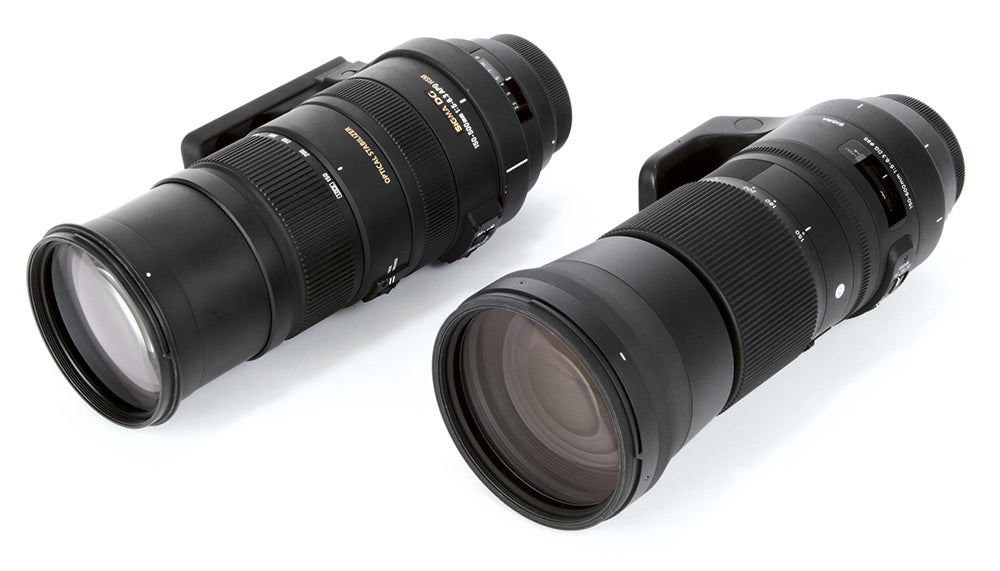Michael Topham tests the new Sigma 150-600mm f/5-6.3 DG OS HSM Contemporary lens side-by-side with Sigma’s popular 150-500mm f/5-6.3 DG OS HSM

To capture this pin-sharp shot the camera’s autofocus system was set to Zone AF with continuous (AI Servo) tracking employed. All photos by Michael Topham
Sigma 150-600 f/5-6.3 DG OS HSM Contemporary – Key specifications
- Price: £900
- Mount: Sigma, Canon, Nikon
- Construction: 20 elements, 14 groups
- Diaphragm blades: 9
- Max aperture: f/5-6.3
- Min aperture: f/22
- Minimum focusing distance: 280cm
- Filter size: 95mm
- Size: 105 x 260.1mm
- Weight: 1,930g
When Tamron unveiled the SP 150-600mm f/5-6.3 Di VC USD lens in November 2013, it became one of the most attractive third-party telephoto zooms for sports and wildlife photographers. Favourable reviews and its ability to zoom closer to the action than Sigma’s popular 150-500mm f/5-6.3 DG OS HSM put pressure on Sigma to produce a rival zoom.
Sigma replied with not one, but two 150-600mm lenses. The first to arrive was the 150-600mm f/5-6.3 DG OS HSM Sport – aimed at pros, with professional-grade optics and excellent durability for challenging, fast-action situations. Its sister model, on test here, is the Sigma 150-600mm f/5-6.3 DG OS HSM Contemporary – a lens geared towards enthusiasts with its more affordable price tag and portable, compact design.
Late last year, I was fortunate enough to be one of the first to try an early sample of the 150-600mm f/5-6.3 DG OS HSM | S and I gave it a thorough test to find out how it performed at shooting motorsport. Extremely impressed by its versatility and all-round performance, I’m eager to find out if Sigma’s Contemporary version is just as good and how it fares against Sigma’s older, yet still very popular, 150-500mm f/5-6.3 DG OS HSM. Before revealing how it performs in the field, let’s look at how the specs shape up on paper.
Specification
The main advantage the Sigma 150-600mm f/5-6.3 DG OS HSM Contemporary has over the older 150-500mm f/5.6-6.3 DG OS HSM is the extra reach at the long end. To ensure the new lens maintains the same variable aperture through its extensive focal range, the front element has been enlarged and where the older 150-500mm had a 86mm filter thread, the 150-600mm’s accepts filters and adapter rings with a 95mm diameter.
The internal construction has also been reworked: there are 20 elements in 14 groups in the new lens, compared to 21 elements in 15 groups in the older model. The new lens features three SLD glass elements much like the 150-500mm, but also includes one FLD glass element, which is known for being the highest-level low-dispersion glass available for high light transmission to counteract chromatic aberration effectively. Based on this, I’m expecting to see an improvement in the way the lens handles aberrations, which I’ll touch on later.
The focusing system relies on Sigma’s Hyper Sonic Motor design (HSM) to deliver high speed and
quiet autofocus, as well as full-time manual-focus override that can be set from the focus-mode switch and adjusted by rotation of the focus ring. It’s also possible to customise the lens and adjust its AF speed and focus-limit settings by pairing it with Sigma’s USB Dock.
Although the Contemporary lens doesn’t employ the same splash and dustproof construction as Sigma’s Sport variant, it does feature rubber sealing around the outside of the brass-made bayonet mount to prevent any ingress of water or dust.
It’s all sounding positive so far, but there are a few caveats to consider. Weighing 1,930g, it’s 150g heavier than the 150-500mm f/5.6-6.3 DG OS HSM, and with a 280cm minimum focusing distance it doesn’t focus as closely. This, and the fact it’s only available in Canon, Nikon and Sigma mounts means that it’s not compatible for everyone. Pentax and Sony users wanting a long telephoto zoom of this variety will be more inclined to look at the older 150-500mm f/5.6-6.3 DG OS HSM that is available in five mounts.
Design
Positioned side-by-side with the 150-500mm f/5.6-6.3 DG OS HSM, the 150-600mm f/5-6.3 DG OS HSM | C has a clean, minimalist design that’s in keeping with Sigma’s line-up of current Contemporary, Art and Sport lenses. It loses the gold lettering previously synonymous with the brand, the focal length markings are clearer to read on the zoom ring, and the tripod collar is now flush to the barrel, whereas it protruded slightly on the older model. The focus-distance indicator sits ahead of the tripod collar, where previously it was positioned behind, and the zoom ring is larger, to make it easier to find when your eye is pressed up against the viewfinder. Regrettably, the same can’t be said for the manual-focus ring, which is fairly thin by comparison and doesn’t provide the same level of grip as the zoom ring.
To prevent the zoom from creeping when it’s carried over the shoulder, the zoom lock can be engaged at any one of the eight marked focal lengths on the barrel. With the lock engaged, a sharp twist of the zoom ring can be used to unlock it instantly – a feature I found particularly useful on the Sport version when I wanted to keep the lens locked to a specific focal length on the move, but then be able to adjust it quickly for a spur-of-the-moment shot. This is an improvement on Sigma’s older 150-500mm that could only be locked at the widest focal length and has to be released in the more conventional way using the lock/unlock switch.
The layout of four switches to control focus mode, focus distance, custom settings and the lens’s optical stabiliser makes the appearance of the lens barrel a little more complex. However, they all add up to offer the user better control directly from the lens. The switch that’s been added
to prevent the autofocus operating across its full distance range is a good example of Sigma’s attention to detail, and it can also be used to ensure the lens doesn’t try to focus too closely on a subject and prevent hunting over greater distances.
The optical stabiliser switch operates in the opposite way on the new model, so rather than flicking the switch forward from behind the camera to switch OS off, it now has to be pulled back. In the same way that the older 150-500mm offered two OS modes, there’s the option to set optical stabilisation to Mode 1 or Mode 2. Mode 1 is intended to compensate for camera shake related to general photography, whereas employing Mode 2 turns off stabilisation in the direction of panning and is designed to enhance the effectiveness of the stabilisation when the lens is being used to capture moving subjects.
Performance

The versatility of the focal range enables you to compose subjects lightly in the frame, as illustrated in this image
As to be expected from a Sigma lens equipped with the company’s Hyper Sonic Motor, autofocus operation is consistently smooth across the focus range and goes about its business in a quiet and unpretentious manner. Testing the lens out in the field in the type of high-speed sporting environment for which it’s made revealed a hasty autofocus speed, just like Sigma’s Sport version. Switching between the older and newer lenses revealed an impressive responsiveness and accuracy from the 150-600mm f/5-6.3 DG OS HSM | C, and it proved to be fractionally faster at acquiring focus than the 150-500mm f/5.6-6.3 DG OS HSM. I also found the 150-600mm slightly faster at acquiring focus when asked to shift from a close subject to a distant one than vice versa.
The optical stabiliser performs admirably too, and like the OS system on the older 150-500mm it allows you to shoot up to 4 stops slower than is otherwise possible. The vital role the OS system plays in compensating for handshake is clear to see through the viewfinder when it’s switched on and off. Plus, as well as operating more quietly than the 150-500mm, I found the positioning of the OS switch and the way it has to be pushed forward to activate OS more intuitive.
Although noticeably lighter and more compact than Sigma’s Sport version, the Contemporary lens remains a fairly heavy optic to carry around on your shoulder all day. Attaching it to a monopod can help to take the weight off. The compromise of having a bit more reach at the long end, however, is the effort involved in shifting the optics to the maximum focal length. Unlike the older 150-500mm, which operates across its zoom range in just under a quarter of a turn of the zoom ring, the newer 150-600mm operates across its range closer to half a turn. This means that while you can zoom from the widest end to full telephoto with a couple of twists from behind the camera on the older 150-500mm, it’s a four-stage process on the newer 150-600mm.
Image quality

Filling the frame with your subject is made even easier with the extra reach Sigma’s new lens offers at 600mm
For prospective buyers and those considering Sigma’s 150-600mm f/5-6.3 DG OS HSM | C as an upgrade from the older 150-500mm f/5.6-6.3 DG OS HSM, the sharpness it resolves and the way it deals with vignetting and chromatic aberrations is crucial. Testing the lens through its focal range at every aperture alongside the 150-500mm uncovered noteworthy differences. With the zoom set to 150mm, the newer 150-600mm exhibits fractionally less vignetting between f/5 and f/8, which is absent altogether by the time f/11 is reached. As expected, vignetting becomes more pronounced as the zoom is extended and corner shading appears at the edges from f/6.3-f/11 between 300mm and 600mm.
Close examination of my test images also revealed that where the aperture begins to close from f/5 to f/5.6 at 174mm on the 150-500mm, it closes at 180mm on the 100-600mm. It’s a similar story at the longer end of the zoom, and where the aperture closes from f/5.6 to f/6.3 at 313mm on the 150-500mm it does so at 388mm on the 150-600mm, which results in it offering the user a slightly faster aperture advantage.
On the subject of sharpness, it was initially difficult to differentiate between the two lenses based on sharpness at the centre of the frame, but a closer inspection around the edge of my test images revealed that the newer 150-600mm is the sharper of the two in the corners. Examining images at close magnification also revealed an improvement in the way the 150-600mm tackles chromatic aberration, with noticeably less purple and green fringing apparent along high-contrast edges. This means less work is required in post-processing to remove it.
Lens hood
The hood that Sigma supplies with the new lens is larger than that used on the 150-500mm f/5.6-6.3 DG OS HSM and is made from plastic. Although it’s not constructed from metal like the hood that fits the Sport lens, it is lighter and the twist-to-lock design makes for fast attachment and removal.
The hood is large enough in terms of its diameter to be rested nose down on a level surface, but it doesn’t feature the same removable and replaceable rubber ring as the Sport variant to help protect it. When I tested the Sport lens last year, the small screw that’s used to secure the hood was lost. Those looking at the Sport version ahead of this Contemporary lens will be glad to know that Sigma has made the necessary modification to ensure that this locking screw is captive and irremovable.
Final thoughts
For enthusiasts who aren’t concerned about their long telephoto zoom being weather sealed to a professional standard, there’s a £600 saving to be made in choosing the 150-600mm f/5-6.3 DG OS HSM | C over Sigma’s 150-600mm f/5-6.3 DG OS HSM | S. Shooting with the newer 150-600mm for over seven hours at Brands Hatch, and switching back and forth between the older 150-500mm, I found that its extra reach gets you that bit closer to filling the frame with a distant subject.
However, this comes at the cost of having to rotate the zoom ring further. I found that zooming from the wider end to full telephoto was indeed faster using the older 150-500mm.
The difference in weight between the two lenses is barely noticeable, but I did find it much more manageable to transport than the 150-600mm f/5-6.3 DG OS HSM | S. Also, I could handhold it for longer periods, before using my monopod for extra support.
The excellent build quality, clean looks and subtle design changes all make it a superior lens; but if you already own the 150-500mm f/5-6.3 DG OS HSM and are considering trading it in, there’ll be a £570-£600 difference to make up, as secondhand retailers are offering around £330 for the older 150-500mm in mint condition.
For the improvements the 150-600mm f/5-6.3 DG OS HSM | C lens brings over the older version, this amount of money may be hard to justify. However, for enthusiasts buying their first serious long telephoto zoom it’s one of the best and most affordable third-party optics.







